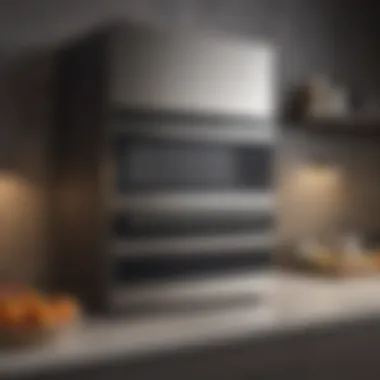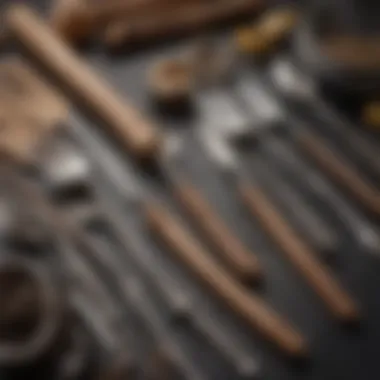Exploring Luxurious Kitchen Items for Culinary Excellence


Intro
The modern kitchen has transformed from a purely functional space into a sanctuary for culinary creativity and aesthetic pleasure. Within this context, the emergence of luxury kitchen items signifies a profound investment in both the art of cooking and the design of kitchen environments. These high-end products are distinguished not only by their premium materials and craftsmanship but also by the advanced technologies that they incorporate.
Luxury kitchenware can elevate everyday cooking experiences, turning mundane tasks into moments of pleasure and indulgence. For passionate food lovers and discerning chefs, outfitting a kitchen with exquisite items represents a philosophy that values quality over quantity, functionality intertwined with beauty, and an appreciation for the craft of cooking itself. This article aims to explore the significance and appeal of luxury kitchen items, covering categories such as cookware, appliances, and tools.
By delving into their features, materials, and the artistry involved in their production, we will uncover how these items not only enhance the practicality of culinary tasks but also contribute to the ambient aesthetics of culinary spaces. Prepare to engage with the aspirational realm of high-end kitchen products, discovering insights that inform and inspire the next steps in your culinary journey.
Preamble to Luxury Kitchen Items
When considering the realm of luxury kitchen items, it is essential to grasp their significance within modern culinary spaces. Luxury kitchenware brings together superior design, innovative features, and a level of craftsmanship that transcends ordinary kitchen tools. They embody not only functionality but also aesthetics, making a statement about taste and lifestyle.
Investing in luxury kitchen items often reflects a commitment to quality and culinary excellence. High-end products can enhance the cooking experience, delivering superior performance and improving the joy of preparing meals. For food lovers, having access to fine tools may inspire creativity and elevate everyday cooking into more sophisticated culinary endeavors.
Moreover, luxury kitchen items often incorporate the latest technologies. This fusion of traditional craftsmanship and modern innovation results in products that are both beautiful and practical. Understanding what defines luxury kitchenware helps consumers make informed choices that suit both their needs and aspirations in the kitchen.
Defining Luxury in Kitchenware
Luxury in kitchenware is a multifaceted concept that goes beyond mere aesthetics. It involves high-quality materials, meticulous craftsmanship, and thoughtful design. At its core, luxury kitchenware is characterized by durability, performance, and an attention to detail that distinguishes it from standard kitchen items.
Many luxury kitchen brands prioritize materials such as high-grade stainless steel, copper, and heavy-duty ceramics. These materials not only enhance performance but also add a refined touch to kitchen aesthetics. Additionally, comfort and usability play a crucial role. Ergonomic designs in utensils, for example, make tasks easier and more efficient, while maintaining a beautiful appearance.
Another important aspect is the storytelling behind the products. Luxury kitchenware brands often have rich histories and traditions, often passed down through generations. These stories add a sense of value and attachment that resonates with consumers seeking more than just functional items.
The Evolution of Kitchen Appliances
The evolution of kitchen appliances illustrates a remarkable journey influenced by technological advancements and changing consumer needs. In the past, kitchen appliances were rudimentary and primarily served basic functions. However, over the decades, we have seen a tremendous transformation.
Early appliances focused on efficiency and manual operation. As technology progressed, innovations such as electricity revolutionized kitchen appliances, providing convenience in meal preparation. The introduction of electric mixers, blenders, and ovens changed culinary practices.
Today, modern appliances integrate smart technology, which not only enhances usability but also promotes energy efficiency. Brands such as KitchenAid and Bosch now incorporate smart features that enable users to control appliances remotely or to automate cooking processes.
Furthermore, sustainability has become increasingly prioritized in the kitchen appliance industry. Innovations now focus on reducing energy consumption, with many appliances designed to minimize waste and promote environmental responsibility. This shift reflects consumers' growing awareness of ecological issues, influencing how products are designed and marketed.
In summary, the discussion about luxury kitchen items is vital as it touches upon design, craftsmanship, and technological evolution, ultimately enhancing our culinary experiences.
Essential Categories of Luxury Kitchen Items
Luxury kitchen items encompass an array of products that elevate cooking and dining experiences. This article focuses on essential categories that include high-end cookware, premium appliances, and innovative gadgets. Understanding these categories helps one appreciate the value they bring to culinary pursuits.
High-End Cookware and Bakeware
Types of Luxury Cookware
Luxury cookware often includes types such as copper, stainless steel, and cast iron. Each material has unique characteristics. For instance, copper provides excellent heat conductivity, leading to precise temperature control. This feature is essential for advanced cooking techniques, making copper a popular choice among professional chefs.
Key characteristic of luxury cookware lies in its durability and ability to withstand high temperatures. Brands like All-Clad and Le Creuset are well-known for their quality offerings. The unique feature of these cookwares often includes non-stick surfaces or the ability to go from stovetop to oven seamlessly, enhancing versatility.
However, there are disadvantages as well. High-end cookware can be quite expensive and requires careful maintenance to preserve its appearance and functionality.
Benefits of Quality Bakeware


When it comes to bakeware, quality matters significantly. High-end bakeware, including items from brands like Nordic Ware and USA Pan, provides even heat distribution, which is crucial for baking success. A key characteristic of these products is their ability to ensure that baked goods rise evenly and develop a perfect crust.
One unique feature of quality bakeware is its resistance to warping and scratching. Such durability can promote long-term usage, making it a worthwhile investment. The advantages of using quality bakeware include less hassle when cleaning and fewer baking mishaps.
Premium Kitchen Appliances
Smart Technology in Appliances
Smart technology is redefining the kitchen appliance experience. Brands like Samsung and LG lead in integrating technology into appliances. A key characteristic here is connectivity, allowing users to control devices via smartphones or voice commands. This beneficial feature enhances convenience, especially for multi-tasking individuals.
Smart refrigerators, for instance, can provide recipes based on available ingredients while ovens can adjust temperature remotely. This level of control can streamline cooking processes, making everything more efficient. Nonetheless, there can be concerns over the learning curves associated with new technology.
Energy Efficiency and Sustainability
Energy efficiency remains a vital consideration in today’s environmentally conscious world. Premium kitchen appliances are now designed to consume less energy without sacrificing performance. For example, Bosch and Whirlpool manufacture dishwashers that exceed standard energy guidelines.
The key characteristic of these devices is their ability to save on electricity bills while reducing the overall carbon footprint. Sustainability is an emerging trend in luxury appliances. Consumers are increasingly drawn to appliances that offer both sophistication and ecological responsibility. However, the initial investment may be higher than standard appliances, which could deter some buyers.
Luxury Kitchen Gadgets
Innovative Tools for Culinary Excellence
Innovative kitchen gadgets continue to evolve. Tools like Sous Vide Supreme and KitchenAid mixers are celebrated for their performance. A key characteristic of these tools is their ability to transform ordinary cooking into an extraordinary experience. They make complex techniques easily accessible, enhancing efficiency and precision in executing gourmet meals.
These gadgets enable a range of culinary techniques, from sous vide cooking to making pasta from scratch. Their advantages include saving time, improving consistency, and encouraging exploration in cooking. On the other hand, some tools can complicate the cooking process, especially for beginners.
Ergonomics and Ease of Use
When selecting kitchen gadgets, ergonomics and ease of use are paramount. Products designed with user comfort in mind, like OXO utensils or Cuisinart kitchen processors, allow prolonged use without discomfort. The beneficial aspect is that these designs reduce strain while enhancing efficiency during food preparation.
Unique features such as soft-grip handles and intuitive controls make these tools attractive to both novice and experienced cooks. The disadvantages, however, may include higher prices compared to standard products, but the investment pays off in comfort and functionality.
Luxury kitchen items not only enhance the functionality of cooking spaces but also contribute to a refined culinary experience by incorporating advanced technology and thoughtful design.
Craftsmanship Behind Luxury Kitchenware
Craftsmanship is at the core of luxury kitchenware. It embodies the skill and dedication that artisans pour into creating each piece. The quality of the products greatly depends on this craftsmanship. Not only does it influence the functionality of kitchen items, but it also adds to their aesthetic value. Thus, understanding craftsmanship is essential for those who appreciate the finer things in cooking and dining.
Materials Used in High-End Items
Stainless Steel and Non-Stick Coatings
Stainless steel is known for its durability and resistance to rust and corrosion. It is a preferred material in high-end cookware because it can withstand high temperatures and retains its appearance over time. One of its key characteristics is its ability to conduct heat evenly, which is crucial for cooking. The non-stick coatings, often applied to cookware, enhance usability by preventing food from sticking, thus making cleanup easier.
A unique feature of non-stick coatings is how they can reduce the amount of oil needed in cooking. This aspect appeals to health-conscious consumers. However, there are also disadvantages. Non-stick surfaces can wear out over time, especially if subjected to high heat or metal utensils. This can lead to scratching and degradation of the coating, affecting its long-term performance. Therefore, while both materials have merits, their selection should align with a cook's priorities and habits.
Natural Materials: Wood and Stone
Natural materials, such as wood and stone, also play a significant role in luxury kitchenware. Wood is favored for its aesthetic appeal and functionality. Many high-end cutting boards and utensils are crafted from hardwoods like maple or walnut. The unique grain patterns not only create visual interest but also provide a natural resistance to knife marks. Wood does not conduct heat as metal does, making it comfortable to handle.
Stone, particularly for surfaces like countertops, brings a timeless elegance. Its durability and resistance to heat make it a practical choice for luxury kitchens. But these natural materials come with considerations too. Wooden items require regular maintenance to avoid drying out or warping. Stone, while durable, can stain if not properly sealed. Therefore, understanding the care needs of these materials is vital for longevity.


The Role of Artisanship
Handmade vs. Machine-Made
When discussing artisanship, one must consider the distinction between handmade and machine-made kitchenware. Handmade items tend to exhibit a level of artistry and personal touch that is hard to replicate with machines. This craftsmanship often leads to greater attention to detail, making each item unique.
Machine-made products, however, can provide consistency in quality. In high-end lines, such as those produced by brands like All-Clad, the balance of efficiency and quality is finely tuned. The challenge lies in ensuring that machine processes do not undermine the aesthetic and functional aspects of the products. Ultimately, consumers must weigh the value of uniqueness versus uniformity when selecting their kitchenware.
Traditions in Craftsmanship
Traditions in craftsmanship carry significant weight in the luxury kitchenware market. Many established brands rely on age-old techniques passed down through generations. These traditions often involve meticulous methods and materials that ensure high quality. For instance, Japanese knife makers utilize centuries-old techniques that result in exceptionally sharp and precise blades.
On the other hand, some new manufacturers embrace innovation to improve efficiency while still respecting traditional methods. These modern practices can enhance durability and performance without sacrificing quality. Understanding these traditions helps consumers appreciate the history and skill behind each luxury item they invest in, creating a deeper connection to their kitchenware.
Craftsmanship in kitchenware is not just about the product's quality; it’s about an emotional engagement with culinary heritage.
The Aesthetic Impact of Luxury Kitchen Items
The visual appeal of a kitchen cannot be understated. Luxury kitchen items play a crucial role in defining the overall ambiance and aesthetic of the culinary space. When one thinks of a luxury kitchen, it is not merely about functionality; it is also about how every piece contributes to the look and feel. Each item, be it a chic cookware set or elegant appliances, adds to a cohesive design, making the kitchen inviting and stylish.
Design Principles in Kitchenware
Form and Function: A Delicate Balance
The principle of form and function is integral in luxury kitchenware. Every item made by top brands is designed not only to perform efficiently but also to look appealing. This balance is essential as it enhances the user experience. For instance, a well-designed pot will heat evenly and look stunning on any stovetop.
A key characteristic of this principle is that it considers ergonomics. Ergonomically designed utensils make cooking more comfortable, which is why they are a favorite choice. A unique feature is that these items often incorporate intuitive designs that allow for ease of use.
However, there may be concerns about durability as some visually stunning items might have a delicate appearance. Care is needed to maintain their beauty and functionality.
The Influence of Color and Texture
Color and texture profoundly influence the ambiance of a kitchen. Typically, luxury kitchen items feature rich hues and varied textures that bring warmth and depth to the space. This approach fosters a welcoming environment, enhancing the overall cooking experience.
A notable characteristic is the use of complementary colors to match a kitchen's decor, making it seem well-coordinated. Some items might incorporate striking textures, making them focal points on countertops.
One unique feature is how certain colors can create a sense of serenity or vibrancy. While lighter colors can feel airy and spacious, darker hues can lend a feeling of sophistication. However, one might face the challenge of keeping these items clean, as they can show stains or wear over time.
Creating an Elegant Culinary Space
Strategic Placement of Items
Proper arrangement of luxury kitchen items is vital. Strategic placement can enhance the kitchen's functionality while also showcasing beautiful pieces. Visually appealing items should be placed where they can be appreciated, yet still be accessible for use.
A key characteristic here is optimization of space. Items placed thoughtfully not only offer easy access but also create harmony in the design. A unique feature about strategic placement is that it can turn functional areas into visual statements, such as displaying cookware on open shelves.
However, overcrowding can lead to a cluttered look, detracting from the elegance of the space. It's essential to strike a balance between accessibility and aesthetics.
Integrating Technology with Classic Design
The integration of modern technology with classic design is another significant aspect. Luxury kitchenware often blends the latest innovations with timeless aesthetics. This combination allows users to enjoy cutting-edge features without sacrificing style.


A vital characteristic is the seamless incorporation of smart appliances that retain elegant lines and finishes. For instance, a sleek, high-tech refrigerator can fit into a traditional kitchen by using complementing materials like stainless steel or wood veneers.
The unique feature of this integration is that it preserves the kitchen's classic charm while enhancing its usability. However, there can be concerns about compatibility and user-friendliness when incorporating sophisticated gadgets into existing designs.
The aesthetic impact of luxury kitchen items goes beyond mere visual appeal; it enhances the functionality and overall enjoyment of the culinary space.
Investing in Luxury Kitchen Items
Investing in luxury kitchen items is crucial for anyone who desires to elevate their culinary experience. These items not only enhance cooking efficiency but also contribute to the aesthetics of the kitchen. When considering luxury kitchenware, it is essential to understand the factors that determine quality and performance, as well as to analyze the cost against long-term benefits.
Evaluating Quality and Performance
Factors to Consider Before Purchasing
Before making a purchase, it is vital to carefully evaluate the quality of the kitchen items. Factors such as durability, materials used, and warranty offer insight into whether a product is built to last. High-quality kitchenware often comprises premium materials like stainless steel or ceramic, which resist wear and tear.
Another essential characteristic is the functionality of the items. Products designed for ease of use typically offer ergonomic grips or intuitive designs. This importance of usability is evident in how well an item performs tasks compared to cheaper alternatives. Moreover, the presence of comprehensive customer reviews can offer valuable information about user experiences that highlight potential advantages or disadvantages of specific products.
Brand Reputation and Reviews
Brand reputation plays a significant role in the purchasing decision. Established brands usually have a history of creating reliable, high-quality kitchen products. They often carry warranties and guarantees, which further secure the investment. Customer reviews can be particularly insightful, providing real-world feedback on performance and longevity.
The unique feature of well-regarded brands is their commitment to quality over cost-cutting measures. This ensures that the items not only meet but often exceed consumer expectations. However, lower brand awareness can also mean affordability, which may appeal to certain buyers looking for value in quality.
The Cost-Benefit Analysis
Long-Term Investment Considerations
Considering long-term benefits is essential when evaluating the cost of luxury kitchen items. High-quality kitchenware may initially require a more considerable investment, but it can save money in the long run. Quality items typically last longer, reducing the need for frequent replacements. Furthermore, premium cookware and tools may enhance cooking capabilities, leading to better meals and increased satisfaction.
A crucial characteristic here is the potential enjoyment that comes from using superior products. For many cooks, the experience of working with well-crafted tools enhances the whole process of preparing meals. However, it is vital to consider personal budget constraints when evaluating these options.
Resale Value of Luxury Items
Luxury kitchen items often retain their value better than standard equivalents. Those looking to upgrade their kitchenware may find it beneficial to invest in items recognized for craftsmanship and heritage. Factors influencing resale value include condition, brand prestige, and market demand.
The unique feature of these products is that they often come with a brand story or heritage—elements that many buyers find appealing. Higher resale value can give consumers confidence that their initial investment will not be lost entirely. However, fluctuating market trends can also impact how much one could get back, especially for less known brands or ordinary items.
Ending: The Significance of Luxury in Culinary Experiences
The exploration of luxury kitchen items reveals their significant impact on culinary experiences. Investing in high-quality kitchenware goes beyond mere aesthetics; it plays a crucial role in enhancing the cooking process. The relationship between kitchen luxury and culinary excellence is profound, influencing everything from preparation to presentation. When individuals choose premium items, they invest in tools that are designed for efficiency and durability. This not only improves performance but also adds a sense of joy and pride in the cooking process itself.
Enhancing Cooking with Quality
Quality in kitchenware translates to better cooking results. High-end cookware and appliances are built with precise engineering, ensuring even heat distribution and superior functionality. Such items often feature advanced materials, which can reduce cooking times and enhance flavor retention. For example, using a premium chef's knife makes cutting vegetables quicker and more enjoyable, while a high-performance blender can create smooth purees that transform recipes.
Furthermore, luxury kitchen items inspire creativity. A well-equipped kitchen invites experimentation with various techniques and cuisines. The satisfaction of cooking with elegant tools elevates the overall experience; it transforms cooking from a chore into a delightful activity. Quality matters, and that quality is found in the details of design, craftsmanship, and functionality.
Future Trends in Luxury Kitchenware
The realm of luxury kitchenware continues to evolve as technology advances. Future trends show a growing emphasis on sustainability and smart technology. Consumers are increasingly looking for items that not only perform well but also contribute to eco-friendly practices. Brands are responding by developing appliances that minimize energy consumption and utilize recyclable materials.
In addition to sustainability, there is a noticeable rise in smart kitchen items. Integrating technology into daily cooking processes enhances convenience and efficiency. For instance, smart ovens that can be controlled via smartphone apps allow for precise cooking and monitoring.
"Investing in quality kitchenware transforms not just your cooking, but the entire cooking experience. This transformation can elevate your culinary journey to new heights."
By embracing these luxury items, culinary enthusiasts can enhance their food preparation and enjoy elevated, delightful cooking adventures.















